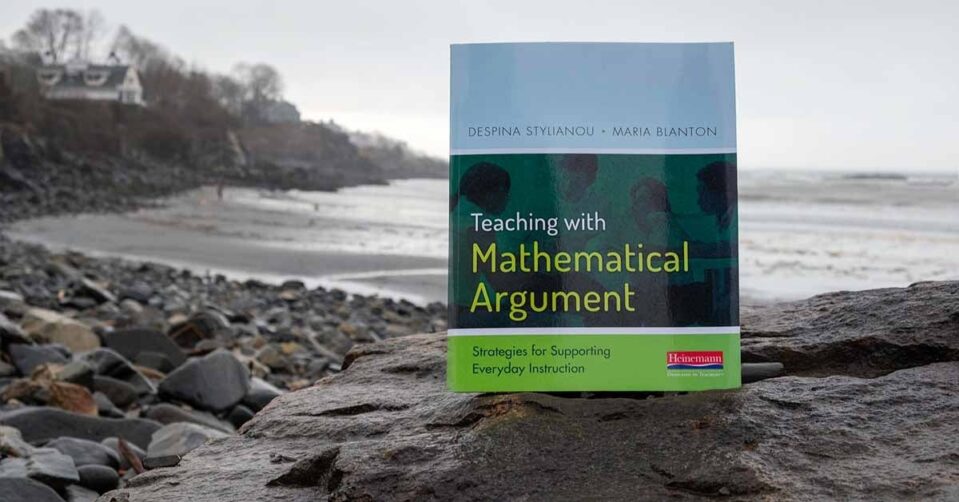
The following has been adapted from Teaching with Mathematical Argument: Strategies for Supporting Everyday Instruction by Despina Stylianou and Maria Blanton
The following has been adapted from Teaching with Mathematical Argument: Strategies for Supporting Everyday Instruction by Despina Stylianou and Maria Blanton
Mathematical reasoning at all ages is based on one's ability to develop sound and convincing arguments. While the formality and form of these arguments will vary across grades, all students need to be able to develop, understand, and interpret arguments appropriate to their level of expertise in mathematics.
The essence of mathematical arguments lies in learning to ask, "Why is this true?" and "How can we convince each other that our conclusions are true?" These questions are important regardless of age or grade level. Even as early as elementary grades, when students are introduced to core mathematical ideas such as operations on numbers, they can learn to build informal arguments that justify the strategies they use in computational work and the validity of the structure and relationships they notice when they operate on numbers.
What is an Argument?
But what exactly is an argument? What makes an argument different from a solution? Scholars have suggested three components of a mathematical argument:
- The claim, that is, the statement that we aim to establish;
- Data -the information we are using to support this claim; and
- Warrants -all the reasons, inferences, and relationships we use to connect the data to the claim
Hence, argumentation in the classroom can occur not only when students provide their solutions and answers to problems but also when they explain how they reached those solutions, shifting the focus from the answer to the process and why the process is appropriate. Providing warrants is one of the most important aspects of argumentation in the mathematics classroom because it makes the reasoning visible and open to justification. Consequently, the single most powerful action a teacher can take to promote argumentation in the classroom is to pose appropriate questions inviting students to make their reasoning explicit by contributing a warrant (Singletary and Conner 2015), that is, naming the inferences or relationships they used.
Attributes of Good Arguments
There are three core attributes of good arguments in school mathematics (Stylianides 2016):
- They are based on ideas or truths accepted and understood by the classroom community.
- They use forms of reasoning that are accessible to students.
- They are communicated with grade-appropriate language.
Mathematical arguments, as well as the ideas on which they are based and the mathematical language they use (including symbols, terms, notations, and representations), evolve as students' mathematical sophistication grows. Students in elementary and middle grades are not expected to craft formal deductive arguments. Students in earlier grades should have opportunities to craft arguments that are compatible with their understanding of mathematical ideas and the use language that makes sense to them. Over time, the ability for students to reason and communicate their reasoning in sophisticated ways will mature as they are exposed to increasingly complex mathematics.
•••
To learn more about Teaching with Mathematical Argument and download a sample chapter, visit Heinemann.com
 Maria Blanton is a Senior Scientist at TERC in Cambridge, Massachusetts. Prior to joining TERC, she was a Professor of Mathematics Education in the STEM Education Department at the University of Massachusetts, Dartmouth. Her work focuses on understanding issues of teacher and student learning associated with algebraic thinking in the elementary grades.
Maria Blanton is a Senior Scientist at TERC in Cambridge, Massachusetts. Prior to joining TERC, she was a Professor of Mathematics Education in the STEM Education Department at the University of Massachusetts, Dartmouth. Her work focuses on understanding issues of teacher and student learning associated with algebraic thinking in the elementary grades.
 Despina A. Stylianou is a Professor of Mathematics Education at The City College of New York. She is also the Director of Mathematics in the City, a center for K–8 professional development focused on mathematics education. Her research interests lie in the area of mathematical cognition; her work explores the mathematical skills, sensibilities, and habits of mind, and actions that are critical to doing, learning, and using mathematics proficiently.
Despina A. Stylianou is a Professor of Mathematics Education at The City College of New York. She is also the Director of Mathematics in the City, a center for K–8 professional development focused on mathematics education. Her research interests lie in the area of mathematical cognition; her work explores the mathematical skills, sensibilities, and habits of mind, and actions that are critical to doing, learning, and using mathematics proficiently.

